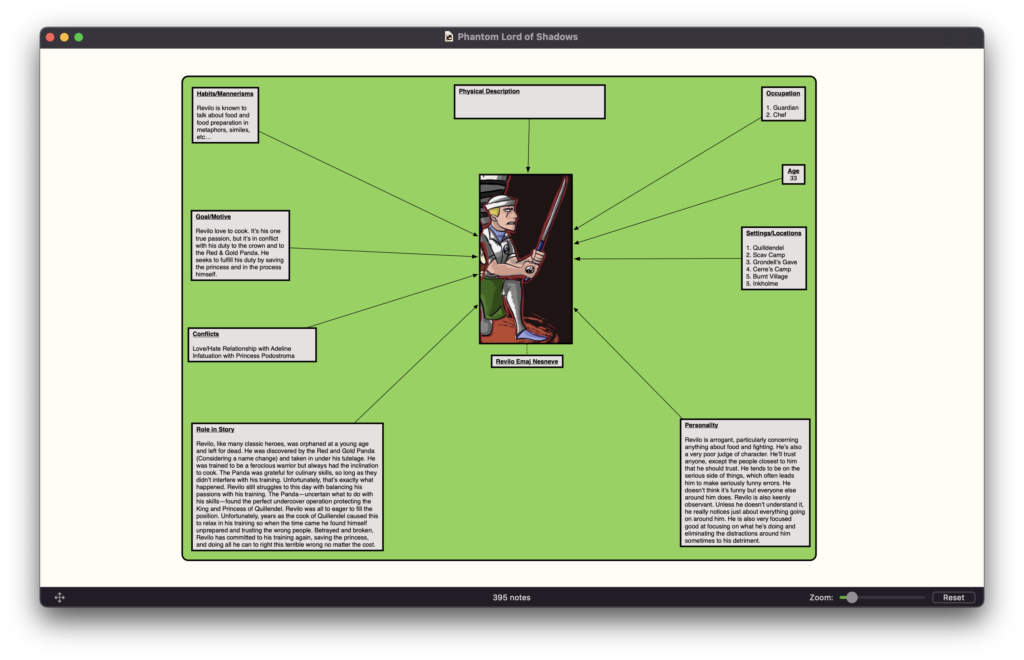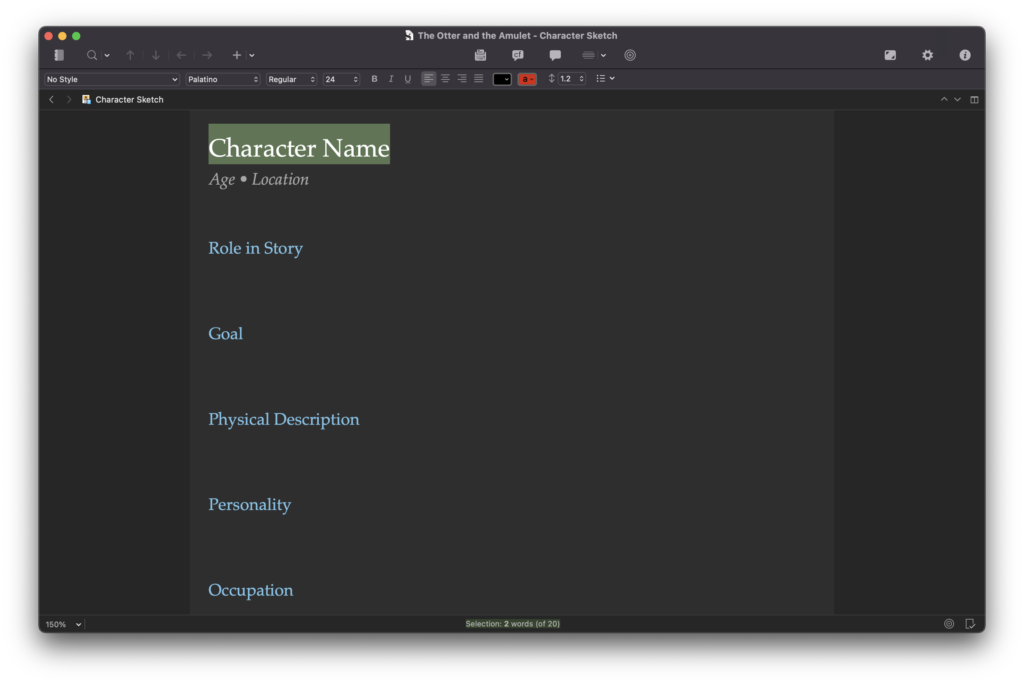Creating believable, three-dimensional characters is one of the most important aspects of writing fiction. In order to create realistic characters, you need to understand their flaws as well as their strengths. This guide will show you how to use Scrivener and Scapple to develop your characters in more depth and make them come alive on the page.
What makes a good character?
A good character should be realistic and believable, with flaws that make them more than just a stereotype. They should be relatable and entertaining, while also conveying human emotions and motivations. Their flaws should drive their story as well as the overall narrative of the novel or screenplay.
How to use Scapple for Character Development
Scapple is another helpful tool you can use for character development. It allows you to quickly brainstorm ideas for flaws that you can use in your characters. You can also make notes and connections between different ideas or plot points, which will help you create a more cohesive story.

Scapple is especially useful for visualizing the relationships between characters. You can draw arrows to show how one character influences another, or add color-coded circles to denote important themes in the narrative. With Scapple, you can easily create a visual map of your character’s relationships and motivations.
How to use Scrivener for Character Development
Scrivener is a great tool for developing characters and their flaws. With its corkboard feature, you can easily lay out all the elements of your character’s backstory and motivations in one place. The split-screen function allows you to work on multiple sections of your project at once, which makes it easier to keep track of all the details.
Scrivener also has a research pane, which you can use to add research from Google searches. You could also add photos to help you flesh out your characters. You can even create character sketches using Scrivener’s stock character template available when you select the Novel Template when first creating your project.

The flaws that make characters interesting and relatable
One of the things that make characters interesting is their flaws. We can all relate to characters who are struggling with something, whether it’s an addiction, a bad temper, or a difficult relationship. Flaws make characters human and relatable, and they can also be the source of conflict and drama in a story. Without flaws, characters would be flat and one-dimensional, and stories would be much less interesting. So next time you’re creating a character, don’t be afraid to give them some flaws. It’s what makes them interesting.
How to use Scrivener and Scapple to map out your characters’ flaws
Scrivener and Scapple are two great tools for mapping out your characters’ flaws. Scrivener is a great tool for organizing your thoughts and keeping track of your ideas, while Scapple allows you to visually map out your characters’ flaws. Here’s how to use could use Scrivener and Scapple to create a comprehensive picture of your character’s flaws:
1. In Scrivener, you can use the existing Character Template or create your own. If you’re unsure of where to start, I recommend starting with your hero, or protagonist. There no need to make homework out of it. Set a timer for 10 minutes and brainstorm some critical information like name, list of characters flaws, age, occupation, and/or backstory. If you enjoy this kind of character creation, keep at it! If not, then it’s time to move on to the next step.
2. In Scapple you could create a mind map for each character and determine what your character’s main flaw will be. Include the character’s main flaw at the center of the map, and branch out from there with other aspects of the character’s personality and backstory that align with your character’s flaws. You might try listing all of the flaws from your character sheet in Scrivener and seeing which one pops out the most after a little brainstorming.
3. With the core ideas of your hero established you can repeat the process for supporting characters and anatagonist, or you can just get started writing and come back to those characters when they pop up in your novel! I’m more inclined to start writing, but the choice is yours! Use both Scrivener and Scapple to keep track of your progress as you develop your characters’ flaws. Refer back to your notes and maps as you write to make sure that your characters are consistent and believable.
By using both Scrivener and Scapple, you can ensure that you have a thorough understanding of your characters’ flaws. This will allow you to write more believable and compelling characters, which will in turn make your story more enjoyable for readers.
Examples of well-developed flawed characters in popular fiction
In every great story, there are characters that readers can’t help but root for, even when they’re flawed. After all, it’s the characters’ flaws that make them relatable and help the story to unfold in interesting ways. Here are a few examples of well-developed flawed characters in popular fiction:
In J.K. Rowling’s Harry Potter series, readers are introduced to a number of unforgettable characters, each with their own unique set of flaws. For example, Hermione Granger is fiercely intelligent but often anxious and over-prepared, while Ron Weasley is fiercely loyal but often jealous and impulsive. Even the titular character, Harry Potter, is far from perfect. He’s brave and determined, but he also makes impulsive decisions and rushes into danger without thinking things through. It’s these flaws that make these characters so compelling and likable, and yes even occasionally frustrating, but as readers we secretly love that.
In Suzanne Collins’ The Hunger Games trilogy, readers are introduced to another set of fascinating characters, each with their own share of flaws. For example, Katniss Everdeen is a natural survivor but she’s also guarded and distrustful of others. Peeta Mellark is a kind and gentle soul but he’s also weak and easily manipulated. Even the notoriously ruthless President Snow is a well-developed character with believable motivations and human vulnerabilities. It’s these flaws that make these characters so complex and engrossing.
These are just a few examples of well-developed flawed characters in popular fiction. What makes these characters so compelling is that they feel real – like people we know in our own lives. Their flaws make them relatable and their journey to overcome those flaws helps to drive the story forward in an interesting way.
Tips for avoiding clichéd or one-dimensional characters
To create depth in your characters, avoid clichés and one-dimensional traits. Instead, give them quirks, contradictions and secrets. Think about what motivates them and what they’re afraid of. What’s their back story? To help you get started, here are a few tips:
1. Give your characters distinctive voices. This can be done by giving them unique speech patterns, vocabulary or mannerisms.
2. Make sure they have flaws. No one is perfect, so don’t make your characters too good to be true. Give them believable faults and insecurities.
3. Develop their relationships with other characters. How do they get along with their friends, family or colleagues? Do they have any unresolved issues?
4. Build up the world around them. What’s their community like? What do they do for fun? What kind of people do they associate with?
5. Finally, don’t forget about physicality! What do your characters look like? How do they carry themselves? All of these details can help to make your characters come alive on the page.
Creating dynamic, three-dimensional characters
When it comes to creating characters, there are a few key elements to keep in mind. First, it’s important to establish who your character is and what their motivations are. What drives them? What are their goals? How do they interact with others? Once you have a clear idea of who your character is, you can start to flesh out their appearance. What do they look like? How do they dress? What kind of body language do they have? These details will help bring your character to life and make them feel more “real” to readers. Finally, don’t forget to give your character some flaws. No one is perfect, and neither should your characters be. By adding some flaws or irregularities, you’ll make them more relatable and human. Overall, remember that creating dynamic, three-dimensional characters is essential for any good story. So take the time to develop them fully, and you’ll be rewarded with rich, interesting stories that will resonate with readers.
Conclusion paragraph: Creating believable, three-dimensional characters is key to writing a successful novel. By understanding what makes a good character and by exploring their flaws, you can create interesting and relatable protagonists and antagonists that will keep your readers engaged until the very end. If you’re looking for more help in developing your characters in Scrivener or Scapple, I’m happy to help. I now offer One on One Scrivener or Scapple Workshop sessions! Thanks for following along with us today!
